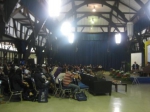ITB AI Center Discussion: Deep Learning Applications for Industry 4.0
By Adi Permana
Editor Adi Permana

BANDUNG, itb.ac.id — On Friday, February 7, 2021, the ITB's Artificial Intelligence (AI) Center hosted a webinar as part of the ITB 101st Anniversary Virtual Exhibition. Two speakers from the School of Electrical Engineering and Informatics (STEI) ITB discussed the topic "Deep Learning for Industry 4.0" in this webinar.
The webinar started with a video presentation of the ITB AI Center, which included the research focus, research products, and lecturers/researchers who are part of it. COVID-19 Social Media Monitoring, COVID-19 detection based on CT-scan and X-ray, crowd detection and safe distance, detection of mask and cough use, and people monitoring and tracing are some of the research items that will be highly important during this pandemic. Cooperation activities such as research collaboration, training/workshops, and seminars are also welcome at the AI ITB Center.
STEI ITB Professor Prof. Dr. Ir. Bambang Riyanto Trilaksono explained deep learning in robotics and autonomous systems, especially autonomous vehicles. Simply said, deep learning is based on computational models of neurons in biological beings' brains, which are subsequently organized into layers called neural networks.
"A robot is a mechanical system that can perform motion and combine electronic systems with sensor systems, controls, actuators to make movements through the feet, hands (limbs) or with a software in which AI or deep learning is implemented," explained Prof. Bambang.
Driverless autonomous cars are one of the technologies related to robotics. The system recognizes nearby objects and measures their distance from the car using camera sensors, radar sensors, and lidar sensors. As a result, the car will be able to make decisions on what to do. Autonomous vehicles are outfitted with a variety of sophisticated technology in addition to sensors.
Prof. Bambang also explained that ITB is currently developing an autonomous tram with PT INKA and Riset.ai startups. "We're working on tram driving assistance that will allow our self-driving tram to recognize objects, avoid collisions, and run speed limit assist features. There will also be driver facial recognition and driver attention warnings to detect whether the driver is asleep or focused," he said.
Afterwards, the application of deep learning in computer vision was explained by Prof. Ir. Dwi Hendratmo Widyantoro, M.Sc., Ph.D. as Chairman of KK Informatics and Professor of STEI ITB. He discussed several issues related to images, such as image classification, image super-resolution, image transformation, image morphing, image captioning, image creation of text descriptions, and the creation of 3D models based on 2D images.
In computer vision, the main idea of deep learning is that there is input in the form of images, and the resultant output is anticipated using deep learning according to the problem. These solutions are then applied for object detection, image segmentation, image coloring, damaged image reconstruction, facial recognition and tracking, motion recognition, medical image analysis (including detecting diseases), to modification of images in a specific style that results in new artwork.
"The performance has been quite impressive. It can even outperform human performance in some circumstances," he expressed his dissatisfaction towards this technology.
Reporter: Ristania Putri Wahyudi (Mathematics, 2019)
Translator: Naffisa Adyan Fekranie (Oceanography, 2019)

.jpg)
.jpg)
.png)
.jpg)
.jpg)



.jpg)